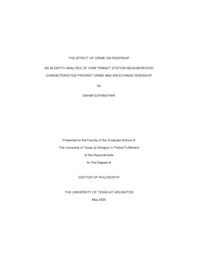
ATTENTION: The works hosted here are being migrated to a new repository that will consolidate resources, improve discoverability, and better show UTA's research impact on the global community. We will update authors as the migration progresses. Please see MavMatrix for more information.
Show simple item record
| dc.contributor.advisor | Li, Jianling | |
| dc.creator | Esfandyari, Sahar | |
| dc.date.accessioned | 2022-07-14T14:16:40Z | |
| dc.date.available | 2022-07-14T14:16:40Z | |
| dc.date.created | 2020-05 | |
| dc.date.issued | 2020-06-01 | |
| dc.date.submitted | May 2020 | |
| dc.identifier.uri | http://hdl.handle.net/10106/30678 | |
| dc.description.abstract | Factors influencing public transit ridership have been widely explored in recent decades. While planners believe that density and mixed land use around transit stations will increase public transit ridership, criminology studies claim that transit stations and their surrounding environments are more prone to criminal activities due to high levels of movement and interaction between unknown persons. This study aims to investigate the impact of crime on Light Rail Transit (LRT) ridership.
Using the geo-locating technique, this study analyzes the spatial distribution of crimes in the half- mile buffer around stations in six Metropolitan Statistical Areas (MSAs): Dallas, Miami, Salt Lake City, Minneapolis, San Diego, and San Francisco. The research also applies Path analysis using Structural Equation Modeling to model the effects of station neighborhoods characteristics, built environment factors and land use attributes and crimes on LRT ridership. The unit of analysis is the half mile buffer around transit stations.
The results show mixed land use has a direct positive significant effect on ridership. Additionally, density has an indirect positive influence on ridership and a direct positive effect on crime as well. Also, there is a full mediation exists between density, crime, and ridership. The model outcome indicates crime has a positive impact on ridership. This positive effect reflects a rise in ridership associated with an increase of criminal incidents due to high activity and high demand of public transit use by captive riders.
The additional analytical section compares regions on factors including walkability and the vegetation around the LRT stations. The ANOVA and Post Hoc test results indicate that Salt Lake City has the lowest walk score among other regions with Dallas having the next lowest walk score region compared to San Francisco and Minneapolis. Miami and San Diego do not have any apparent significant difference in mean score compared to other regions.
This study’s contribution is examining the role of crime on ridership. Although transit-oriented development policies encourage density around the stations, density may threaten the area by attracting criminal activities. Crime prevention through environmental design guidelines could be followed that could change the impact of density on crime attraction around stations and deter crime. However, the most important step is creating a sense of community through an all-inclusive approach to physical, social, and economic development. | |
| dc.format.mimetype | application/pdf | |
| dc.language.iso | en_US | |
| dc.subject | Ridership | |
| dc.subject | Crime | |
| dc.subject | Structural Equation Modeling | |
| dc.title | THE EFFECT OF CRIME ON RIDERSHIP, AN IN-DEPTH ANALYSIS OF HOW TRANSIT STATION NEIGHBORHOOD CHARACTERISTICS PREVENT CRIME AND ENCOURAGE RIDERSHIP | |
| dc.type | Thesis | |
| dc.date.updated | 2022-07-14T14:16:40Z | |
| thesis.degree.department | Urban and Public Affairs | |
| thesis.degree.grantor | The University of Texas at Arlington | |
| thesis.degree.level | Doctoral | |
| thesis.degree.name | Doctor of Philosophy in Urban Planning and Public Policy | |
| dc.type.material | text | |
Files in this item
- Name:
- ESFANDYARI-DISSERTATION-2020.pdf
- Size:
- 1.832Mb
- Format:
- PDF
This item appears in the following Collection(s)
Show simple item record


